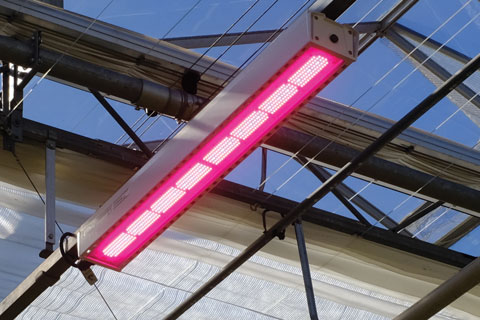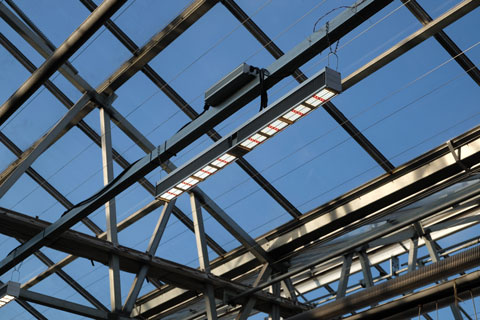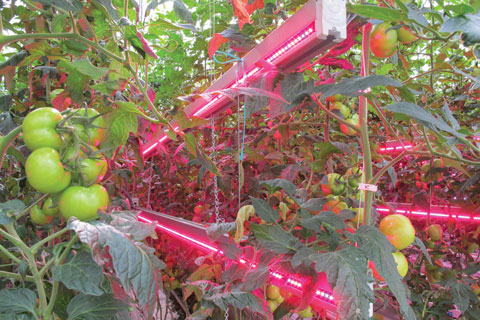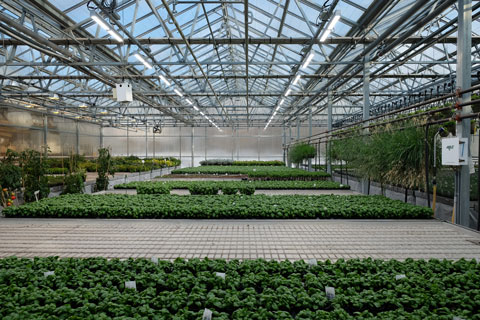4/1/2022
A Quick Look Into LEDs
A.J. Both

While the use of light-emitting diode (LED) fixtures is expanding, questions remain about whether this is cost-effective. LED fixtures have several advantages, including their often lower electricity consumption compared to a high-pressure sodium (HPS) fixture that produces a similar light output.
Pictured: A high-output and passively cooled LED fixture designed to replace an overhead HPS fixture. The magenta color is produced from a combination of red and blue wavelengths.
LED fixtures can be designed to deliver a fixed light spectrum or certain models can be adjusted so they can deliver a range of different spectra. These fixed or adjustable spectra can be tailored to specific plant species, cultivars and/or growth stages. The heat produced by LED fixtures can be converted to warm air that can be managed in controlled environments. The largely radiant heat produced by HPS lamps is more challenging to manage and can result in uneven heating of taller crop canopies. As a result, we can place LED fixtures closer to our crops, reducing unintended light losses.
Some LED fixtures have a dimming feature, allowing for more continuous adjustments of their light output. This can be helpful when the fixtures are used to supplement sunlight (e.g., when maintaining a specific light intensity is desirable) or when a more gradual ramping of the light intensity is desired (e.g., in an indoor growing facility).
The pricing picture
Combined, these advantages are quite an improvement compared to the capabilities of HPS fixtures. However, most LED fixtures designed for use by commercial plant growers have prices that are two to four times higher compared to HPS fixtures with similar light output. We’ve been told that LED fixture prices will come down when more growers start using them, but so far that predicted price drop has been disappointing. As a result, many growers have stuck with HPS fixtures, even for new installations. It’s a familiar technology and the industry has a lot of experience growing a wide range of crops under HPS light.
 Pictured: A high-output and passively cooled LED fixture designed to replace an overhead HPS fixture. This fixture produces white light from a combination of blue, green and red wavelengths.
Pictured: A high-output and passively cooled LED fixture designed to replace an overhead HPS fixture. This fixture produces white light from a combination of blue, green and red wavelengths.
It would be unfair to solely blame the LED fixture manufacturers for the higher fixture prices. The market for plant growth fixtures is quite unique and relatively small, especially compared to the market for human vision applications. Fixtures used for plant growth applications operate in more challenging environments (e.g., larger temperature fluctuations, high humidity, long operating hours). And some of the plant’s spectral requirements necessitate the use of wavelength-specific LEDs that are less efficient and/or more challenging to acquire.
So will the LED fixture price come down in the near future? Only time will tell. I think the answer is yes, but I predict fixture prices will remain higher compared to HPS fixtures for quite some time.
Research: Your own and from others
So what’s a grower to do? It’s clear that LED fixtures have several very appealing advantages, but the price differential is quite substantial. Of course, when the lower electricity consumption is considered over the useful life of the fixtures, the higher initial purchase price can be recovered over time. The length of the so-called pay-back period will be an important factor in the decision-making process. The shorter the better. A detailed discussion with your banker and electric utility company can help you decide what the best strategy is for your operation. Such a discussion may also reveal that there are certain incentives/rebates and/or electricity rate schedules that can help finance a switch from HPS to LED fixtures or a new installation of LED fixtures.
One intermediate approach is to try LED fixtures on a small area, and if possible, do a side-by-side comparison with the current lighting system. This will keep the installation cost manageable and will provide key information that can be used for the decision about whether to make a complete switch to LED lighting.
 Pictured: LED fixtures mounted within a tomato canopy. This placement reduces unintended light losses. In order to deliver more light to this crop, the plants can additionally be lit from overhead mounted fixtures.
Pictured: LED fixtures mounted within a tomato canopy. This placement reduces unintended light losses. In order to deliver more light to this crop, the plants can additionally be lit from overhead mounted fixtures.
Because LED lighting systems are a relatively new technology for horticultural applications, we still have a lot to learn when it comes to optimizing their use for all the different crops we grow in controlled environments. There’s a lot of research going on at universities and government agencies, but the relatively large number of variables involved make this a time-consuming process. It’ll take time before optimized lighting recipes become available for growing crops with the help of LED lighting systems.
A related challenge is that some of the research is deemed proprietary, especially when it’s conducted by commercial operations, resulting in situations where “the wheel has to be reinvented” repeatedly. While I understand the desire to protect intellectual property, I’m also a fan of the saying, “A rising tide lifts all boats.” More openness and information-sharing will benefit the entire industry and can eventually help bring the cost of LEDs lighting down for everyone.
That’s not to say that useful information about the use of LED fixtures isn’t available. Several manufacturers post research findings from their own R&D projects and a number of researchers have reported on their experiments in extension and scientific publications. The rapid rise of fully enclosed crop production systems—including specialized systems to grow cannabis—has put a spotlight on the challenges of controlled environment crop production, including plant lighting.
In my opinio n, this has been a positive development that has increased our knowledge and directed more resources toward the development of efficient LED lighting systems. The speed of these developments has been high, so I encourage growers to stay informed, and interact with manufacturers and researchers as often as they can. It’s not unusual for a top-of-the-line fixture model to be replaced by a newer model with even more features within a time period of only a couple of years. And the horticultural lighting industry has seen its fair share of consolidations and manufacturers going out of business, so it’s important to stay in the know.
n, this has been a positive development that has increased our knowledge and directed more resources toward the development of efficient LED lighting systems. The speed of these developments has been high, so I encourage growers to stay informed, and interact with manufacturers and researchers as often as they can. It’s not unusual for a top-of-the-line fixture model to be replaced by a newer model with even more features within a time period of only a couple of years. And the horticultural lighting industry has seen its fair share of consolidations and manufacturers going out of business, so it’s important to stay in the know.
Pictured: White light-producing LED fixtures mounted above basil plants that are grown in pots placed on ebb-and-flood benches.
The electricity elephant
Finally, I would be remiss if I didn’t address another “elephant in the room”: The high electricity consumption associated with supplemental or sole-source lighting for crop production. When that electricity is produced by burning fossil fuels, the associated emissions contribute to the global warming trends we all hear about in the news. If we want to maintain our “green” image as an industry, having high energy consumption (including energy needed for heating and cooling) isn’t a long-term sustainable approach. Reducing our electricity consumption and/or switching to alternative energy sources will be necessary whether we like it or not. So far our industry has avoided most of the outside scrutiny of our energy consumption, but as regulations and public opinions shift, it’s likely our industry will be affected as well.
I firmly believe that it’s better to be prepared for such changes than to wait until we’re forced to change our practices. Therefore, as an industry, I think we should be proactive and work on solutions that will reduce our energy consumption and related environmental impacts. Partnerships—including growers, researchers, utilities companies, equipment manufacturers and funding agencies—are needed to implement a comprehensive strategy that focuses on reducing the overall energy consumption across our industry. I encourage growers to include this aspect of crop lighting in their decisions about how best to use lighting in their operations. GT
A.J. Both is a Professor and Extension Specialist in the Department of Environmental Sciences at Rutgers University. He can be reached at both@sebs.rutgers.edu.